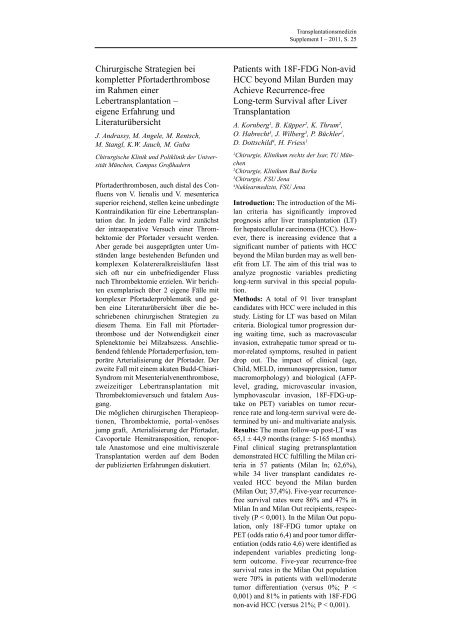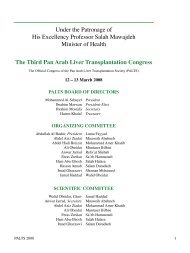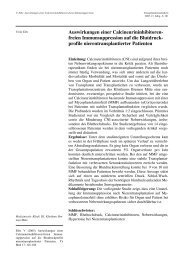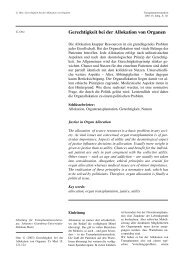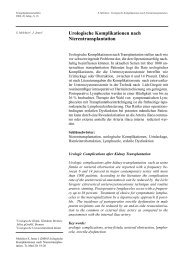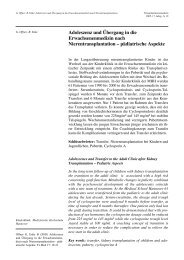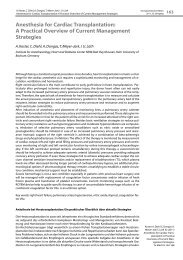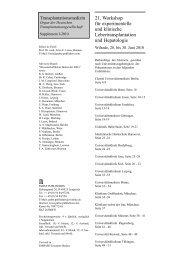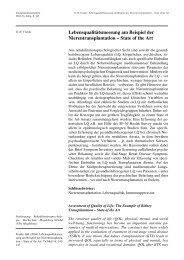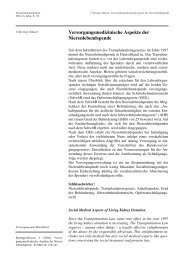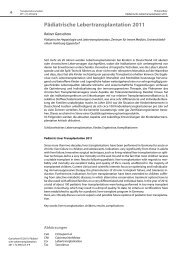22. Workshop für experimentelle und klinische Lebertransplantation ...
22. Workshop für experimentelle und klinische Lebertransplantation ...
22. Workshop für experimentelle und klinische Lebertransplantation ...
Erfolgreiche ePaper selbst erstellen
Machen Sie aus Ihren PDF Publikationen ein blätterbares Flipbook mit unserer einzigartigen Google optimierten e-Paper Software.
Transplantationsmedizin<br />
Supplement I – 2011, S. 25<br />
Chirurgische Strategien bei<br />
kompletter Pfortaderthrombose<br />
im Rahmen einer<br />
<strong>Lebertransplantation</strong> –<br />
eigene Erfahrung <strong>und</strong><br />
Literaturübersicht<br />
J. Andrassy, M. Angele, M. Rentsch,<br />
M. Stangl, K.W. Jauch, M. Guba<br />
Chirurgische Klinik <strong>und</strong> Poliklinik der Universität<br />
München, Campus Großhadern<br />
Pfortaderthrombosen, auch distal des Confluens<br />
von V. lienalis <strong>und</strong> V. mesenterica<br />
superior reichend, stellen keine unbedingte<br />
Kontraindikation für eine <strong>Lebertransplantation</strong><br />
dar. In jedem Falle wird zunächst<br />
der intraoperative Versuch einer Thrombektomie<br />
der Pfortader versucht werden.<br />
Aber gerade bei ausgeprägten unter Umständen<br />
lange bestehenden Bef<strong>und</strong>en <strong>und</strong><br />
komplexen Kolatereralkreisläufen lässt<br />
sich oft nur ein unbefriedigender Fluss<br />
nach Thrombektomie erzielen. Wir berichten<br />
exemplarisch über 2 eigene Fälle mit<br />
komplexer Pfortaderproblematik <strong>und</strong> geben<br />
eine Literaturübersicht über die beschriebenen<br />
chirurgischen Strategien zu<br />
diesem Thema. Ein Fall mit Pfortaderthrombose<br />
<strong>und</strong> der Notwendigkeit einer<br />
Splenektomie bei Milzabszess. Anschließendend<br />
fehlende Pfortaderperfusion, temporäre<br />
Arterialisierung der Pfortader. Der<br />
zweite Fall mit einem akuten Budd-Chiari-<br />
Syndrom mit Mesenterialvenenthrombose,<br />
zweizeitiger <strong>Lebertransplantation</strong> mit<br />
Thrombektomieversuch <strong>und</strong> fatalem Ausgang.<br />
Die möglichen chirurgischen Therapieoptionen,<br />
Thrombektomie, portal-venöses<br />
jump graft, Arterialisierung der Pfortader,<br />
Cavoportale Hemitransposition, renoportale<br />
Anastomose <strong>und</strong> eine multiviszerale<br />
Transplantation werden auf dem Boden<br />
der publizierten Erfahrungen diskutiert.<br />
Patients with 18F-FDG Non-avid<br />
HCC beyond Milan Burden may<br />
Achieve Recurrence-free<br />
Long-term Survival after Liver<br />
Transplantation<br />
A. Kornberg 1 , B. Küpper 2 , K. Thrum 2 ,<br />
O. Habrecht 3 , J. Wilberg 3 , P. Büchler 1 ,<br />
D. Dottschild 4 , H. Friess 1<br />
1<br />
Chirurgie, Klinikum rechts der Isar, TU München<br />
2<br />
Chirurgie, Klinikum Bad Berka<br />
3<br />
Chirurgie, FSU Jena<br />
4<br />
Nuklearmedizin, FSU Jena<br />
Introduction: The introduction of the Milan<br />
criteria has significantly improved<br />
prognosis after liver transplantation (LT)<br />
for hepatocellular carcinoma (HCC). However,<br />
there is increasing evidence that a<br />
significant number of patients with HCC<br />
beyond the Milan burden may as well benefit<br />
from LT. The aim of this trial was to<br />
analyze prognostic variables predicting<br />
long-term survival in this special population.<br />
Methods: A total of 91 liver transplant<br />
candidates with HCC were included in this<br />
study. Listing for LT was based on Milan<br />
criteria. Biological tumor progression during<br />
waiting time, such as macrovascular<br />
invasion, extrahepatic tumor spread or tumor-related<br />
symptoms, resulted in patient<br />
drop out. The impact of clinical (age,<br />
Child, MELD, immunosuppression, tumor<br />
macromorphology) and biological (AFPlevel,<br />
grading, microvascular invasion,<br />
lymphovascular invasion, 18F-FDG-uptake<br />
on PET) variables on tumor recurrence<br />
rate and long-term survival were determined<br />
by uni- and multivariate analysis.<br />
Results: The mean follow-up post-LT was<br />
65,1 ± 44,9 months (range: 5-165 months).<br />
Final clinical staging pretransplantation<br />
demonstrated HCC fulfilling the Milan criteria<br />
in 57 patients (Milan In; 62,6%),<br />
while 34 liver transplant candidates revealed<br />
HCC beyond the Milan burden<br />
(Milan Out; 37,4%). Five-year recurrencefree<br />
survival rates were 86% and 47% in<br />
Milan In and Milan Out recipients, respectively<br />
(P < 0,001). In the Milan Out population,<br />
only 18F-FDG tumor uptake on<br />
PET (odds ratio 6,4) and poor tumor differentiation<br />
(odds ratio 4,6) were identified as<br />
independent variables predicting longterm<br />
outcome. Five-year recurrence-free<br />
survival rates in the Milan Out population<br />
were 70% in patients with well/moderate<br />
tumor differentiation (versus 0%; P <<br />
0,001) and 81% in patients with 18F-FDG<br />
non-avid HCC (versus 21%; P < 0,001).


